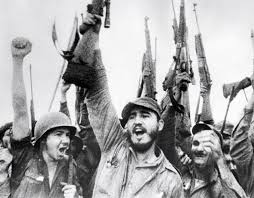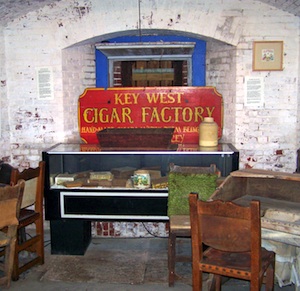My third post will start with the renowned 1980 Mariel boatlift. In 1980, Cuban president Fidel Castro opened up the port of Mariel, Castro released a statement inviting the Cuban immigrants of the United States to sail back to Cuba and pick up their relatives. Thousands of Cubans took advantage of this possibility and sailed from the United States to Cuba, hoping to bring back their families in what came to be known as the Mariel boatlift.
The political climate in Cuba during the 1980s was tumultuous. The Castro regime had become a Communist dictatorship where Cubans felt continuously oppressed. In 1965 Castro created the UMAP ( Unidades Militares para la Ayuda de Producción) or Military Units to Help Production. The UMAP were labor camps that served as a way to get rid of Castro’s enemies, pretty much everybody with political affiliations that differed from those of the government (Cordova, 35)
The Cuban population grew in discontent with the government and its repeated abuses of power. The standard of living had decreased by 1970s, high levels of unemployment were also a common problem. Castro’s brilliant idea to end unemployment was to criminalize it! In 1971the Anti-Loafing Act was passed , the unemployed population would be sent to jail(Cordova, 42).
Political dissidents were also held in prison, they were sometimes tortured and faced inhumane prison conditions. Homosexuals were assigned to a “special” type of prison in which they went through a re-education program to “cure” their “disease”. Motivated by the harsh conditions at the time, a bus full of Cuban people crashed in the Peruvian embassy in Cuba, seeking political asylum in 1979 (Cordova, 57).
The 1980 Mariel boatlift followed quickly, after Castro allowed certain people to leave the country. Thousands of Cubans living in the United States rushed to the Mariel Port in Cuba to pick up their families (Larzelere, 27).
Thousands of Cubans migrated to the United States (Florida to be exact), using yachts, sailboats and even freighters; approximately 125,000 Cubans were transported to the United States. The Cuban immigrants were received with open arms by the US government and by the American population, who saw them as victims of the evil communism.
This good attitude towards the newcomers changed drastically when Castro released a statement saying that amongst the people who migrated to the US were criminals, prostitutes, drug addicts, homosexuals and mental health patients. Castro sent his “unwanted” people to the United States (Larzelere, 43-50). some of these included:
- Julio Gonzalez, arsonist and mass murderer
- Pedro Medina, he was executed for killing a Floridian girl in 1982
- Luis Felipe, he was a convicted murderer and founder of a Latin gang
Not all the Marielitos (as they were known) were criminals:
- Mirta Ojito, writer and Pulitzer prize winner
- Elizabeth Caballero, opera singer
- Rene Lavan, actor and soap opera star
- Reinaldo Arenas, poet and novelist
Popular discontent towards the Cubans immigrants thanks to the intense media coverage of Castro’s plan to send the “undesirables”. Americans began to see the Cubans of Mariel with fear and horror, many “concerned citizens” sent letters to the White House demanding the expulsion of the Mariel Cubans. Americans made the mistake to believe that all the Cubans of Mariel were criminals. According to government investigations, 2,000 to 5,000 of the Cubans of Mariel had committed serious crimes in Cuba; the U.S. Immigration and Naturalization Service apprehended over 1,000 of them (Jimenez, 215).
The following video shows media propaganda against the Cubans of Mariel in Miami.
Americans refused to believe that most of the immigrants were law abiding citizens. They accused the Carter Administration of making the U.S. Cuba’s dumping ground for criminals. Arguing that the crime rates increased sharply after their arrival, there was a 66 percent increase in crime rates in Miami, Florida (where most Cubans were settling) (Jimenez, 218).
The Mariel boatlift came to an end in October 1980, after only six months. Many of these immigrants did not qualify for refugee status under the 1980 U.S. Refugee Act, so the government granted them a temporary entrant status. Under the temporary entrant status, allowed them to seek employment and receive a limited amount of public assistance. In 1984 the U.S. government finally decided that the Cubans of the Mariel boatlift qualified for US citizenship (Larzelere, 126).
The Cubans of Mariel faced a tremendous amount of discrimination because of the criminal accusations implied by the media. They left their country in search of a better life, and the cruel reality of discrimination proved that they would not get it in their host country. They faced discrimination while trying to find decent housing and employment (Larzelere, 128).
While some Cubans in Florida raised millions of dollars for relied and settlement efforts, others turned against the newcomers afraid that their reputation might be damaged. Women and Children had an easier time finding people willing to help them. Many Americans went as far as opening their homes to single women or families. Women were also able to find jobs faster than men because many employers saw them as safer than males (Jimenez, 150).
Just like their earlier counterparts, Cuban women of Mariel found jobs as domestics, seamstress, cooks, dishwashers, waitresses and other service occupations. These women were already used to work outside the home to support the family due to Cuba’s unstable economy (Gracia, 78) .
Many Cuban women of Mariel had relatives in the United States to help them adapt to the new society. These women had the support of a family network to help them find work, housing, schools for their children and they also had friends that they could talk to and rely on (Jimenez, 59).
Cuban women of Mariel were also invested in the political issues of their homeland. Just like previous female Cuban emigrants, the Cuban women of Mariel had participated in a series of campaigns against the Castro government, including demonstrations and organized letter writing campaigns (Kanellos, 169).
Cuban women in the United States also created political organizations to gather support against the Castro regime. These organizations included the Union de Mujeres (Union of Women), Cruzada Femenina Cubana (Cuban Femenine Crusade) and Movimiento Femenino Anticomunista (Anti-communist Femmenine Movement) (Kanellos, 170).
The government began the implementation of new policies to decrease the number of illegal immigrants in the United States. The Immigration Reform and Control Act of 1986, required employers to verify a future employee’s immigration status prior to being hired. In other words, hiring an illegal immigrant was officially illegal and punishable by law (Fox, 89).
Another famous policy was the “Wet Feet, Dry Feet” policy of 1995. Basically if Cubans are caught in the water (the ocean) while attempting to enter the United States, the Coast Guard could send them back to Cuba. Cubans who successfully made it to shore were allowed to stay and seek citizenship; basically a game of “luck” (Benson, 185).
These new policies made it harder for Cubans to migrate to the United States. These policies were created to discourage the Cuba-US migration, but the attempts never stopped. Every year hundreds of Cubans begin the journey to the United States, they pay smugglers to get them out of Cuba and into the US illegally, they take great risks in their journey to freedom. Their desperation is so big that they attempt to make the journey using fragile “boats” others have tried to make the journey by converting trucks or cars onto floatation devices.
Cuban Women’s access to jobs has expanded quite a bit over the past couple of years. The typical jobs available to their nineteenth and twentieth century counterparts are still available for them in addition to the already mentioned new opportunities. Many Cuban women work as live in domestics or nannies, while I lived in Miami I was surprised to see the amount of Cuban women working as nannies for both, American and Cuban families (Jimenez, 218).
Cuban men in Florida are now able to accumulate significant amount of wealth, they can work as lawyers, doctors and successful business owners. Cuban women also obtained greater access to jobs, it is common to find a Cuban doctor or lawyers in Miami. The real state business also opened up a lot of job opportunities for Cuban women; currently there are thousands of Cuban women working as real state brokers in South Florida (Fox, 126).
Cuban women, in the twentieth-first century, are also able to open their own businesses. If you ever visit the popular Calle 8 (8th Street) in Miami you will find a series of Cuban owned businesses. Cuban women gravitated towards jobs associated with the female gender role, lots of Cuban women have opened day care centers, cleaning companies, laundry centers, dry-cleaners, beauty salons, restaurants, schools etc.
Many Cuban women are currently struggling against the “Americanization” if their children. Cubans in the United States are fighting to keep their heritage alive and pass it on to their children. Cuban women try to develop a Cuban identity in their children by doing simple things such as cooking traditional Cuban food, talking to them in Spanish and teaching them about their homeland. These efforts help strengthen and unify the community; it also helps them to create a sense of pride towards their culture (Grenier, 65).
I find it really ironic that these people take such a tremendous risk to come to the United States, believing that their lives would take a turn for the best once they get there. But things are not as easy as they think. It is true that the United States offer many opportunities for advancement, it is also worth mentioning the fact that the path leading to these “great opportunities” is a path full of sacrifice and hard work.
Currently, Cubans are facing a great amount of discrimination, many Americans believe that Cubans are occupying their jobs, especially because Cubans work for lower wages. Americans also believe that Cubans represent a burden to the US economy and that they live off of the social welfare (paid by American taxpayers) that corresponds to Americans (Gracia, 122) .
Important Cuban Women
- In 1989: Ileana Ros-Lehtinen became the first elected Cuban congresswoman
- Daisy Fuentes (Television host and model), first Latina working for the popular American Network MTV
- Celia Cruz, Cuban salsa artist. Most of her work was in the United States because she was against the Castro government
- Gloria Stefan, Cuban singer and songwriter. She has won 37 Grammy Awards, she was raised in Miami after her family fled the Cuban revolution
- Maria Teresa, Grand Duchess of Luxembourg. Married to Grand Duke Henri of Luxembourg
Bibliography:
Córdova, Efrén. 40 años de revolución: el legado de Castro. 1. ed. Miami, Fla.: Ediciones Universal, 1999. Print.
Fox, Geoffrey E.. Working-class emigres from Cuba. Palo Alto, Calif.: R & E Research Associates, 1979. Print.
Gracia, Jorge J. E., and Pablo Greiff. Hispanics/Latinos in the United States: ethnicity, race, and rights. New York: Routledge, 2000. Print.
Grenier, Guillermo J., and Lisandro Pérez. The legacy of exile: Cubans in the United States. Boston: Allyn and Bacon, 2003. Print.
Larzelere, Alex. The 1980 Cuban Boatlift. Washington, D.C.: National Defense University Press, 1988. Print.
Benson, Sonia. The Hispanic American almanac: a reference work on Hispanics in the United States. 3rd ed. Detroit: Gale, 2003. Print.
Jiménez, Alfredo, Nicolás Kanellos, Claudio Fabregat, and Maria Cristina Garcia. Handbook of Hispanic cultures in the United States. Houston, TX: Arte Público Press ;, 1994. Print.
Kanellos, Nicolás, and Cristelia Pérez. Chronology of Hispanic-American history: from pre-Columbian times to the present. New York: Gale Research, 1995. Print.
Images:
Image 2: http://www.uscg.mil/history/gifs/Mariel_Boatlift_1_sm.jpg
Image 3: http://www.miamibeach411.com/ee/images/uploads/mariel-boat-lift.jpg
Image 4: http://repeatingislands.files.wordpress.com/2012/10/mariel650.jpg?w=500&h=307
Image 5: http://weblogs.sun-sentinel.com/news/politics/dcblog/Cuban%20migration.jpg
Image 6: http://www.latinamericanstudies.org/immigration/truck-raft-1.jpg
Image 8: http://www.panama-guide.com/images/articles/20120303101735890_1.jpg
Image 9: http://31749149.nhd.weebly.com/uploads/1/4/1/4/14149778/8544902_orig.jpg?329
Image 10: http://clatl.com/freshloaf/files/2009/04/immigrationweb_024.jpg
Image 11: http://patdollard.com/wp-content/uploads/2012/07/Immigration_protest.jpg






























